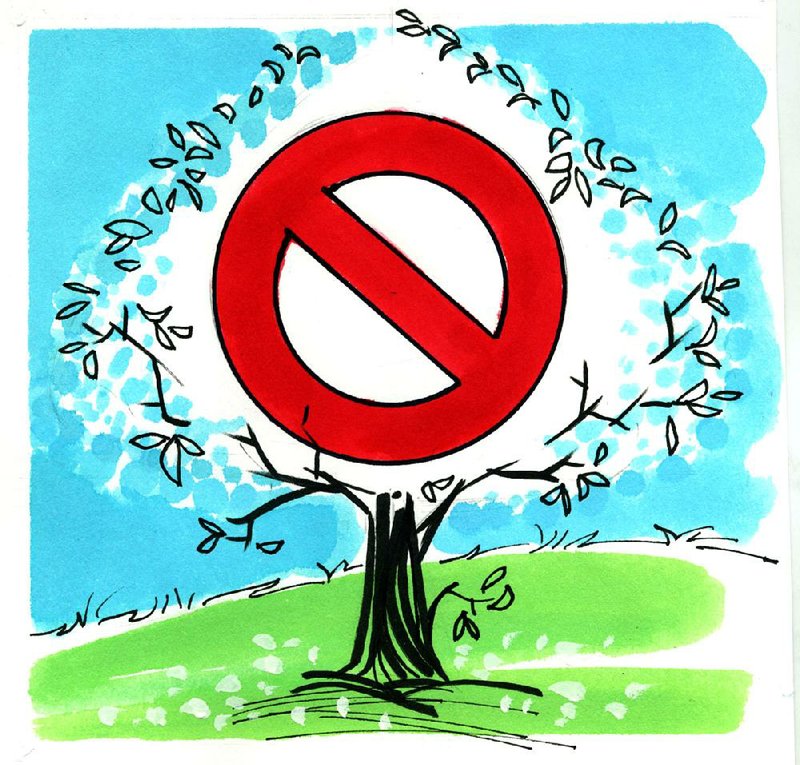Q I have read in some of your columns about your dislike of all the blooming pear trees around Arkansas. I think they are beautiful. Why do you not like them?
A There are several reasons for my dislike of the ornamental pears. When first planted here they were new and unknown, supposedly disease-resistant and with a perfect round shape. While they do have beautiful white blooms in the spring and outstanding red foliage in the fall, their dense, teardrop shape makes them quite susceptible to storm damage. The overplanting of them has also led to diseases, with fire blight, a bacterial disease, gaining a foothold. They are also not small trees at maturity and yet often are planted close to people's homes, which can lead to property damage. All of that is enough to cause concern, but the real culprit is the huge amount of fruit they set, which the birds are attracted to. Birds eat and drop the seeds in the forest and everywhere, resulting in wild seedlings taking over native vegetation. The growth is so rapid and thick that there is little room for anything else to grow. Then the resulting seedlings set their own blooms and fruit, and the problem is compounded. So, when planting a new tree, try something else besides an ornamental pear. Diversity is good for the landscape and the environment.
Q I had two small fig trees in my garden that I planted last summer. One is leafing out great, but the other only has a sprout at the base. What should I do? Will I get any figs this year?
A While this past winter was not as hard on us as the one before, still, we have experienced some winter damage. Figs, hydrangeas and a few gardenias are a bit nipped. Cut off any dead growth and retrain your tree. Figs have the potential to bear fruit on the new growth, but if it is starting from the base, unless you get rampant growth I wouldn't expect much production.
Q I recently got quite a few bare root trees from the Forestry Commission. I know they need to be planted ASAP, but if I can't water, should I plant them in the ground and let them take their chances or put them in containers now and plant later? I could have the pots close enough to a water source that I could water.
A All trees will do better with supplemental water for their first year or two. I definitely suggest putting them in pots, watering to keep them going all summer and then planting in the fall. Planting trees in the fall gives them a better shot at survival, since the roots can become established with more natural moisture than we have in the summer. In winter they don't have to supply nourishment to foliage, so they can focus on building a strong network of roots and thus have a better shot of surviving a dry summer the next year. When you do plant, mulch them well with two to three inches of mulch to help conserve moisture. Planting them now would not give them much of a head start before hot, dry weather occurs, and the risk of mortality will increase.
Q I am starting with fresh soil this year in my garden for my tomatoes, so hopefully I will have fewer disease problems. I have had the bottom of the tomato turning black for two years in a row. I have been told it is a water issue and not a disease, but whatever it is, it takes my tomatoes. What can I do besides start with clean soil to prevent this?
A The problem is actually a calcium deficiency caused by fluctuating moisture levels, and it is called blossom end rot. It is worse on some varieties than others. Add a little lime to the planting hole and mulch the plants well. Then try to keep the soil as evenly moist as possible. It is often when we go from feast to famine -- really dry soil and then a heavy downpour -- that we see the first signs of the blossom end rot.
Q I was out in the woods and saw this grove of big leaves with beautiful white flowers. What are they and can I buy them for my own garden?
A The plant in question is a May apple. It is a great woodland plant that can serve as a short-season ground cover. It has beautiful white flowers that are borne under the leaves, which tend to hide them a bit. It also produces a fairly large fruit, thus the common name. May apple colonizes by rhizomes, forming dense mats in damp, open woods. The common name refers to the May blooming of its apple-blossom-like flower and resulting fruit. Although the leaves, roots, and seeds are poisonous, the fruits are edible. When ripe, the golden-yellow fruits can be used in jellies, but often wildlife eat them before you get to them. They are a spring ephemeral, disappearing by mid to late summer. They are available from some nurseries, but also native plant nurseries carry them. In Arkansas, Pine Ridge Gardens carries them.
Janet B. Carson is a horticulture specialist for the University of Arkansas Cooperative Extension Service. Write to her at 2301 S. University Ave., Little Rock, Ark. 72204 or email her at
HomeStyle on 04/18/2015

